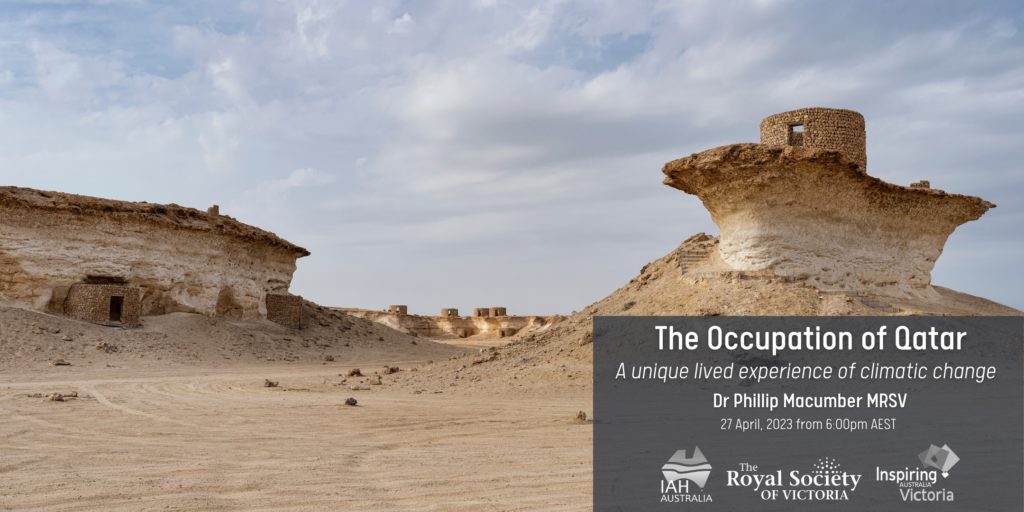The Occupation of Qatar – a lived experience of climatic change
**Event cancelled due to low registration numbers. Apologies to all who were intending to attend. We plan to film Dr Macumber’s presentation for sharing online in the weeks to come.**

Central to any holistic understanding of water heritage in arid settings is the relationship between occupation and the natural environment – why people live where they do. This is especially the case in Qatar, where low rainfall and high temperatures coupled with low relief result in the absence of fresh surface water and a relatively hostile natural environment.
Only 7% of the land is arable, and the otherwise bare limestone surface has mostly skeletal soils. Unlike many of its Persian Gulf neighbours, there are no supporting streams, springs or aflaj. Instead, there is a band of hypersaline coastal sabkha, an outcome of mid-late Holocene climatic change. In essence, Qatar is a hot, hyperarid, waterless desert with a hypersaline perimeter. Occupation has historically been at the limits of habitability, requiring special adaptabilities.
The only source of water is a fragile groundwater lens, found only in the north, being a relic from an early-Holocene monsoonal climate, and maintained despite the hyper-arid conditions by a unique pattern of recharge centred on numerous small karstic depressions – the rawdha (Arabic for ‘garden’ or ‘meadow’). The presence of the freshwater lens, and hence occupation, of Qatar was determined by four factors – palaeoclimate, eustatics, geology and geomorphology.
Join veteran hydrogeologist Dr Phillip Macumber to trace a 150,000 year history of human activity on the Qatar peninsula, a rich account brought together by geology, hydrology, climatology, regional mythology and archaeology.
About the Speaker
 Dr Phillip Macumber is the principal hydrogeologist of Phillip Macumber Consulting Services, specialising in environmental hydrology and hydrogeology in Victoria. With qualifications in geology, geomorphology, Middle Eastern studies and the history and philosophy of science, he completed his PhD in hydrogeology with the University of Melbourne.
Dr Phillip Macumber is the principal hydrogeologist of Phillip Macumber Consulting Services, specialising in environmental hydrology and hydrogeology in Victoria. With qualifications in geology, geomorphology, Middle Eastern studies and the history and philosophy of science, he completed his PhD in hydrogeology with the University of Melbourne.
His early work was as a hydrogeologist in the Victorian Department of Mines, mostly in northern Victoria, where he traced the highly auriferous fluviatile deep leads from the highlands across the Loddon Valley to where they merged with marine sequences in the Kerang-Cohuna area in the north. On the basis of hydrograph responses in the Loddon Valley bores, Phil showed that instability in the groundwater systems was the cause of the salinity problems being experienced across southern Australia, providing a refocus for its treatment. In 1986 he joined the Department of Water Resources and was Chair of the Victorian Government’s salinity investigation committee. The results of the Victorian work were documented in his PhD thesis and published in Groundwater-Surface Water Interactions in Northern Victoria (1991).
Over a 20-year period from 1980, Phil also worked as a geomorphologist with Sydney University Department of Archaeology on their annual expedition to Pella in Jordan. After completing his primary task on the Pella Tell, he went on to discover the Lower Palaeolithic (500,000 to 200,000 yr. BP) Mashariah sites and the later Wadi Hammeh sites, where in 50 m thick vertical wadi sections there is continuous occupation for 60,000 years covering Middle, Upper and Epipalaeolithic sites ending with the well-known 12,000-year-old Natufian Wadi Hammeh 26.
From 1991 to 1998 Phil lived in Oman and worked for the Department of Water Resources, including as head of hydrogeology. Much of the work centred on investigating precipitation sources and fresh-water lenses, both modern and fossil, in the otherwise saline, hyper-arid Al Wusta region in central Oman. In northern Oman, Phil worked on seawater intrusion in the Al Batinah coastal Plain.

In 2009 at the behest of Copenhagen University Department of Archaeology, Phil went to Qatar to assist as a geomorphologist on their excavation and investigations at Al Zubarah, which was in 2013 declared a world heritage site. While there he investigated the nature of occupation in a country that was essentially a hyper-arid waterless low relief desert where the higher buildings of Doha are 3 times the height of the highest point in the landscape. Despite virtually no relief and certainly no surface water, his 400-p book The Role of Water and Landscape in the Occupation of Qatar was published by Qatar University Press in 2021.






